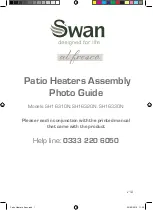
100324051_2000579115 _Rev. 01
www.hotwater .com 43
OPERATING THE TEMPERATURE CONTROL SYSTEM
Install Thermostatic Mixing Valves (see Figure 6) to
regulate the temperature of the water supplied to each
point-of-use (for example, kitchen sink, bathroom sink,
bath, shower). Install and adjust the mixing valve according
to its manufacturer’s instructions.
It is recommended that lower water temperatures be used
to avoid the risk of scalding. It is further recommended,
in all cases, that the water temperature be set for the
lowest temperature which satisfies your hot-water needs.
This will also provide the most energy efficient operation
of the water heater.
Short repeated heating cycles caused by small hot-water
uses can cause a temperature increase of the hot water
by 30F° higher than the heater’s temperature settings. If
you experience this type of use you should consider using
lower temperature settings to reduce scald hazards.
WARNING! Even if the water heater’s thermostat is set
to a relatively low temperature, hot water can scald.
Install Thermostatic Mixing Valves (see Figure 6) at
each point-of-use to reduce the risk of scalding.
Should overheating occur or the gas supply fails to shut
off, turn off the main manual gas shut off valve to the
appliance (see Figure 1).
Water temperature over
125°F can cause severe
burns instantly resulting in
severe injury or death.
Children, the elderly and the
disabled are at highest risk
of scald injury.
Feel water before bathing or
showering.
Temperature limiting devices
such as mixing valves must
be installed when required
by codes and to ensure safe
temperatures at fixtures.
BURN
HOT
HOT
DANGER
HOT WATER CAN SCALD:
Water heaters are intended to produce hot water.
Water heated to a temperature which will satisfy space
heating, clothes washing, dish washing, cleaning and
other sanitizing needs can scald and permanently injure
you upon contact. Some people are more likely to be
permanently injured by hot water than others. These
include the elderly, children, the infirm, or physically/
mentally handicapped. If anyone using hot water fits into
one of these groups or if there is a local code or state law
requiring certain temperature water at the hot-water tap,
then you must take special precautions. In addition to
using lowest possible temperature setting that satisfies
demand of application, to reduce the risk of scalding,
install Thermostatic Mixing Valves (temperature limiting
valves) (see Figure 6) at each point-of-use. These
valves automatically mix hot and cold water to limit the
temperature at the tap. Before changing the factory setting
on the thermostat, in this manual, see Table 9.
The water heater should be located in an area where
the general public does not have access. If a suitable
area is not available, a cover should be installed over the
thermostat to prevent tampering.
This water heater is equipped with an adjustable
thermostat to control water temperature (see Figure 48).
Hot water temperatures required for automatic dishwasher
and laundry use can cause scald burns resulting in serious
personal injury and/or death. The temperature at which
injury occurs varies with the person’s age and time of the
exposure. The slower response time of children, aged or
disabled persons increases the hazards to them. Never
allow small children to use a hot-water tap, or to draw their
own bath water. Never leave a child or disabled person
unattended in a bathtub or shower.
The hot setting shown on the dial is approximately 120°F.
This is a good starting point to set the temperature.
Setting the water heater temperature at 120°F will reduce
the risk of scalds.
The thermostat settings on the gas control valve are shown
in Figure 48.
The water temperature setting was factory set at the lowest
(VAC) temperature setting.
WARNING! Higher temperatures increase the risk of
scalding, but even at 120°F, hot water can scald. (See
Table 9). Install Thermostatic Mixing Valve(s) (see
Figure 6) at each point-of-use to reduce the risk of
scalding.
















































